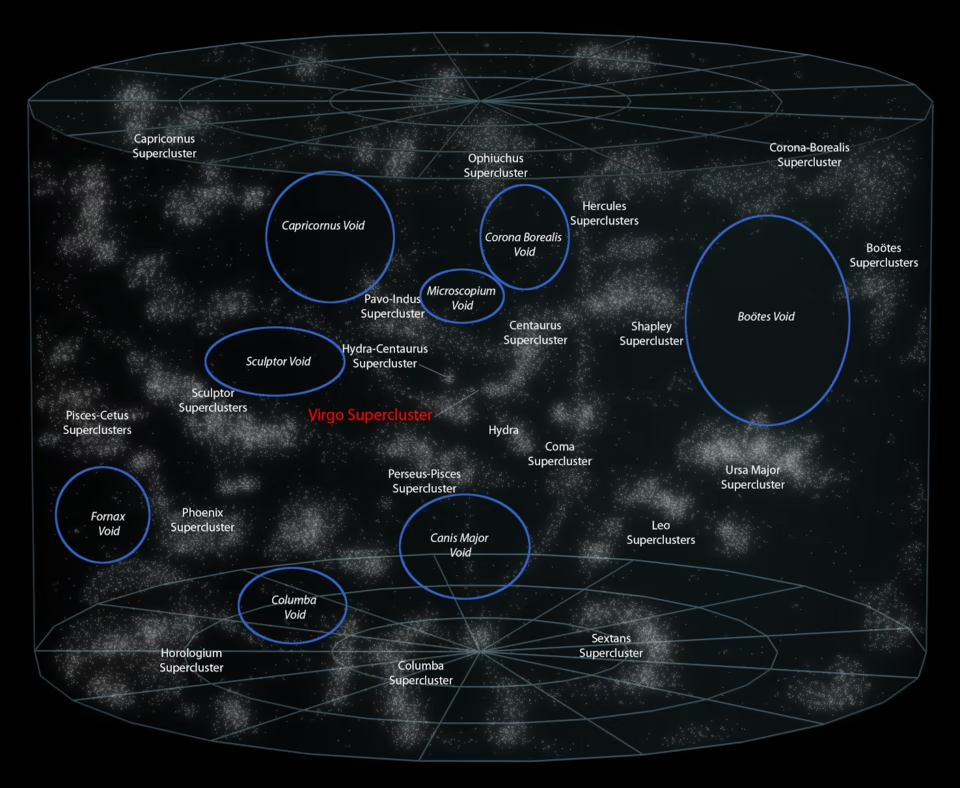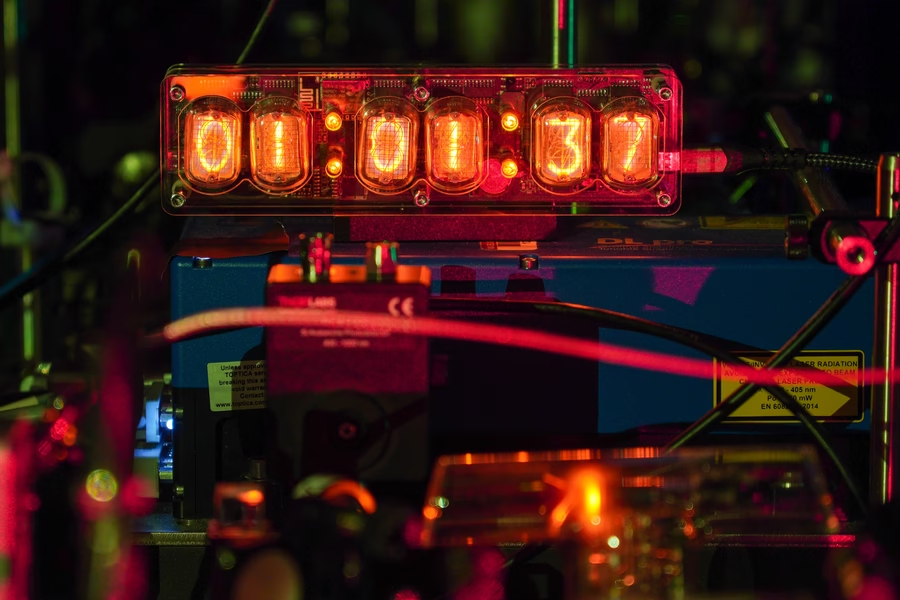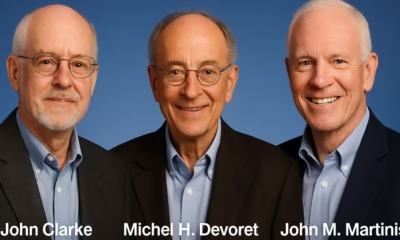Space & Physics
Could dark energy be a trick played by time?
David Wiltshire, a cosmologist at New Zealand’s University of Canterbury, proposed an alternate model that gets rid of dark energy entirely. But in doing so, it sacrifices an assumption cosmologists had held sacred for decades.

In 1924, American astronomer Edwin Hubble discovered that our universe expands in all directions. Powering this expansion was a Big Bang, an event that marked the birth of our current universe some 13.7 billion years ago. Back then, the finding came as a jolt to the astronomy community and the whole world. In 1998, there was even further shake-up when observations of type 1A supernovae from distant galaxies indicated the universe was expanding – at an accelerated rate. But the source of its driving force have remained in the dark.
Dark energy was born from efforts to explain the accelerated expansion. It remains a placeholder name for an undetected energy density contribution that offers a repulsive effect counterbalancing gravity’s attractive nature at long distances. Consensus emerged in support of this dark energy model thereafter. In 2011, astronomers behind the type 1A supernovae study went on to share the Nobel Prize in Physics.
More than two decades later, we are none the wiser to uncover what dark energy is. However, cosmologists have deemed it to be a constant of nature, one that does not evolve with time. So was the surprise when preliminary findings from the Dark Energy Spectroscopic Instrument (DESI) survey indicated dark energy was not just variable, but also weakening over time. The Lambda-Cold Dark Matter, more technically known as the standard model, has never stood on shakier grounds.
Fine-tuned to a Big Crunch ending
In cosmological models, the Greek letter “Lambda” fits as a placeholder for dark energy. It depicts a major chunk – some 70% of the universe’s energy density. But this figure holds only if it is a true cosmological constant. If dark energy is variable, then inevitable we end up fine-tuning the universe’s fate. A constant dark energy would yield a universe expanding forever.
But going by DESI’s preliminary findings, if dark energy is weakening over time, the the universe is set to collapse on itself in the far future. This is the Big Crunch hypothesis. It was amidst the caucus surrounding DESI’s latest findings, the cosmology community took interest in a paper published in the December edition of the Monthly Notices of the Royal Astronomical Society.
In 2007, David Wiltshire, a cosmologist at New Zealand’s University of Canterbury, and the paper’s co-author, had proposed an alternate model called timescape cosmology, to get rid of dark energy entirely. It requires a sacrifice over an assumption cosmologists have held so sacred in their models. Known as cosmological principle, it shares much in common with Aristotle and Ptolemy’s outdated viewpoint that the earth was at the center of the solar system.
A special place in the universe
The cosmological principle assumes matter in the universe is distributed uniformly everywhere on average, and in every direction that we look around. But cosmologists propose to adopt a pragmatic approach like the Polish Prussian astronomer, Nicholas Copernicus, had proposed in the 16th century. In the Copernican model of the solar system, the earth bore no special location in it. Likewise, timescape cosmology requires earth to not occupy a special location.
Saying that, the cosmological principle has a certain appeal among cosmologists. Theoretical calculations would appear complex to manipulate discarding uniformity. At the same time, cosmologists do contend that something has to give way, in light of astronomical observations that contend the cosmological principle is indeed outright wrong.

Inhabiting a time bubble
One of the hallmark phenomena in Einstein’s general theory of relativity is gravitational time dilation. Time passes slower under a gravitational field. Bizarre as though it may seem to be, experiments have proven this subtle, but measurable effect.
In 1959, two Harvard physicists Robert Pound and Glen Rebka Jr. used a pair of atomic clocks to demonstrate this effect – also known as gravitational time dilation. Two clocks were stationed in their office building – one atop the roof, and the other closer to earth. The clock stationed closer to earth, lagged in comparison to the one atop the roof. Here, time dilation occurs in response to earth’s gravity tugging weakly at the clock atop, compared to the one below.
The universe looks clumpier in certain directions at cosmic scales than others. Galaxies bind together under gravity to form strands like that of a vast, interconnected cosmic web. Voids of cosmic proportions occupy the space in between. These voids experience a faster time flow, since they’re subject to weaker gravity from the surrounding galaxies. But observers in these galaxies have a skewed perception of time, since they’re living embedded inside a bubble of strong gravity. Events outside their time bubble play out akin to a fast-forwarded YouTube video.
Not the end of dark energy
Distant galaxies appears to recede accelerated in the reference frame of our time bubble. That appearance is a mere temporal illusion; an effect David Wiltshire says we falsely assume to be dark energy. So far, timescape cosmology has only occupied a niche interest in cosmology circles. There is far too little evidence to support a claim that dark energy affects arise truly from us inhabiting a time bubble.
Cosmologists had taken to social media to critique Wiltshire’s use of type 1A supernovae datasets used in his analysis. Saying that, none of the critiques themselves are conclusive. As observations pile up in the future, there may come a definitive closure. Until then it’s a waiting game for more data and refined analysis. Meanwhile on the contrary, it is too early to abdicate dark energy as a concept altogether. Lambda-CDM model would be the first to undergo a major rehaul, should DESI’s preliminary findings hold in successive observational runs. Until then, we can only speculate the universe’s fate.
Space & Physics
MIT Pioneers Real-Time Observation of Unconventional Superconductivity in Magic-Angle Graphene
Physicists have directly observed unconventional superconductivity in magic-angle twisted tri-layer graphene using a new experimental platform, revealing a unique pairing mechanism

MIT physicists have unveiled compelling direct evidence for unconventional superconductivity in “magic-angle” twisted tri-layer graphene—an atomically engineered material that could reimagine the future of energy transport and quantum technologies. Their new experiment marks a pivotal step forward, offering a fresh perspective on how electrons synchronize in precisely stacked two-dimensional materials, potentially laying the groundwork for next-generation superconductors that function well above current temperature limits.
Instead of looking merely at theoretical possibilities, the MIT team built a novel platform that lets researchers visualize the superconducting gap “as it emerges in real-time within 2D materials,” said co-lead author Shuwen Sun in a media statement. This gap is crucial, reflecting how robust the material’s superconducting state is during temperature changes—a key indicator for practical applications.
What’s striking, said Jeong Min Park, study co-lead author, is that the superconducting gap in magic-angle graphene differs starkly from the smooth, uniform profile seen in conventional superconductors. “We observed a V-shaped gap that reveals an entirely new pairing mechanism—possibly driven by the electrons themselves, rather than crystal vibrations,” Park said. Such direct measurement is a “first” for the field, giving scientists a more refined tool for identifying and understanding unconventional superconductivity.
Senior author Pablo Jarillo-Herrero emphasized that their method could help crack the code behind room-temperature superconductors: “This breakthrough may trigger deeper insights not just for graphene, but for the entire class of twistronic materials. Imagine grids and quantum computers that operate with zero energy loss—this is the holy grail we’re moving toward,” Jarillo-Herrero said in the MIT release.
Collaborators included scientists from Japan’s National Institute for Materials Science, broadening the impact of the research. The discovery builds on years of progress since the first magic-angle graphene experiments in 2018, opening what many now call the “twistronics” era—a field driven by stacking and twisting atom-thin materials to unlock uniquely quantum properties.
Looking ahead, the team plans to expand its analysis to other ultra-thin structures, hoping to map out electronic behavior not only for superconductors, but for a wider range of correlated quantum phases. “We can now directly observe electron pairs compete and coexist with other quantum states—this could allow us to design new materials from the ground up,” said Park in her public statement.
The research underscores the value of visualization in fundamental physics, suggesting that direct observation may be the missing link to controlling quantum phenomena for efficient, room-temperature technology.
Space & Physics
Atoms Speak Out: Physicists Use Electrons as Messengers to Unlock Secrets of the Nucleus
Physicists at MIT have devised a table-top method to peer inside an atom’s nucleus using the atom’s own electrons

Physicists at MIT have developed a pioneering method to look inside an atom’s nucleus — using the atom’s own electrons as tiny messengers within molecules rather than massive particle accelerators.
In a study published in science, the researchers demonstrated this approach using molecules of radium monofluoride, which pair a radioactive radium atom with a fluoride atom. The molecules act like miniature laboratories where electrons naturally experience extremely strong electric fields. Under these conditions, some electrons briefly penetrate the radium nucleus, interacting directly with protons and neutrons inside. This rare intrusion leaves behind a measurable energy shift, allowing scientists to infer details about the nucleus’ internal structure.
The team observed that these energy shifts, though minute — about one millionth of the energy of a laser photon — provide unambiguous evidence of interactions occurring inside the nucleus rather than outside it. “We now have proof that we can sample inside the nucleus,” said Ronald Fernando Garcia Ruiz, the Thomas A. Franck Associate Professor of Physics at MIT, in a statement. “It’s like being able to measure a battery’s electric field. People can measure its field outside, but to measure inside the battery is far more challenging. And that’s what we can do now.”
Traditionally, exploring nuclear interiors required kilometer-long particle accelerators to smash high-speed beams of electrons into targets. The MIT technique, by contrast, achieves similar insight with a table-top molecular setup. It makes use of the molecule’s natural electric environment to magnify these subtle interactions.
The radium nucleus, unlike most which are spherical, has an asymmetric “pear” shape that makes it a powerful system for studying violations of fundamental physical symmetries — phenomena that could help explain why the universe contains far more matter than antimatter. “The radium nucleus is predicted to be an amplifier of this symmetry breaking, because its nucleus is asymmetric in charge and mass, which is quite unusual,” Garcia Ruiz explained.
To conduct their experiments, the researchers produced radium monofluoride molecules at CERN’s Collinear Resonance Ionization Spectroscopy (CRIS) facility, trapped and cooled them in laser-guided chambers, and then measured laser-induced energy transitions with extreme precision. The work involved MIT physicists Shane Wilkins, Silviu-Marian Udrescu, and Alex Brinson, alongside international collaborators.
“Radium is naturally radioactive, with a short lifetime, and we can currently only produce radium monofluoride molecules in tiny quantities,” said Wilkins. “We therefore need incredibly sensitive techniques to be able to measure them.”
As Udrescu added, “When you put this radioactive atom inside of a molecule, the internal electric field that its electrons experience is orders of magnitude larger compared to the fields we can produce and apply in a lab. In a way, the molecule acts like a giant particle collider and gives us a better chance to probe the radium’s nucleus.”
Going forward, the MIT team aims to cool and align these molecules so that the orientation of their pear-shaped nuclei can be controlled for even more detailed mapping. “Radium-containing molecules are predicted to be exceptionally sensitive systems in which to search for violations of the fundamental symmetries of nature,” Garcia Ruiz said. “We now have a way to carry out that search”
Space & Physics
Physicists Double Precision of Optical Atomic Clocks with New Laser Technique
MIT researchers develop a quantum-enhanced method that doubles the precision and stability of optical atomic clocks, paving the way for portable, ultra-accurate timekeeping.

MIT physicists have unveiled a new technique that could significantly improve the precision and stability of next-generation optical atomic clocks, devices that underpin everything from mobile transactions to navigation apps. In a recent media statement, the MIT team explained: “Every time you check the time on your phone, make an online transaction, or use a navigation app, you are depending on the precision of atomic clocks. An atomic clock keeps time by relying on the ‘ticks’ of atoms as they naturally oscillate at rock-steady frequencies.”
Current atomic clocks rely on cesium atoms tracked with lasers at microwave frequencies, but scientists are advancing to clocks based on faster-ticking atoms like ytterbium, which can be tracked with lasers at higher, optical frequencies and discern intervals up to 100 trillion times per second.
A research group at MIT, led by Vladan Vuletić, the Lester Wolfe Professor of Physics, detailed that their newly developed method harnesses a laser-induced “global phase” in ytterbium atoms and boosts this effect using quantum amplification. Vuletić stated, “We think our method can help make these clocks transportable and deployable to where they’re needed.” The approach, called global phase spectroscopy, doubles the precision of an optical atomic clock, enabling it to resolve twice as many ticks per second compared to standard setups, and promises further gains with increasing atom counts.
The technique could pave the way for portable optical atomic clocks able to measure all manner of phenomena in various locations. Vuletić summarized the broader scientific ambitions: “With these clocks, people are trying to detect dark matter and dark energy, and test whether there really are just four fundamental forces, and even to see if these clocks can predict earthquakes.”
The MIT team has previously demonstrated improved clock precision by quantumly entangling hundreds of ytterbium atoms and using time reversal tricks to amplify their signals. Their latest advance applies these methods to much faster optical frequencies, where stabilizing the clock laser has always been a major challenge. “When you have atoms that tick 100 trillion times per second, that’s 10,000 times faster than the frequency of microwaves,” said Vuletić in the statement. Their experiments revealed a surprisingly useful “global phase” information about the laser frequency, previously thought irrelevant, unlocking the potential for even greater accuracy.
The research, led by Vuletić and joined by Leon Zaporski, Qi Liu, Gustavo Velez, Matthew Radzihovsky, Zeyang Li, Simone Colombo, and Edwin Pedrozo-Peñafiel of the MIT-Harvard Center for Ultracold Atoms, was published in Nature. They believe the technical benefits of the new method will make atomic clocks easier to run and enable stable, transportable clocks fit for future scientific exploration, including earthquake prediction, fundamental physics, and global time standards.
-

 Space & Physics6 months ago
Space & Physics6 months agoIs Time Travel Possible? Exploring the Science Behind the Concept
-

 Know The Scientist6 months ago
Know The Scientist6 months agoNarlikar – the rare Indian scientist who penned short stories
-

 Know The Scientist5 months ago
Know The Scientist5 months agoRemembering S.N. Bose, the underrated maestro in quantum physics
-

 Space & Physics3 months ago
Space & Physics3 months agoJoint NASA-ISRO radar satellite is the most powerful built to date
-

 Society5 months ago
Society5 months agoAxiom-4 will see an Indian astronaut depart for outer space after 41 years
-

 Society5 months ago
Society5 months agoShukla is now India’s first astronaut in decades to visit outer space
-

 Society5 months ago
Society5 months agoWhy the Arts Matter As Much As Science or Math
-

 Earth5 months ago
Earth5 months agoWorld Environment Day 2025: “Beating plastic pollution”























